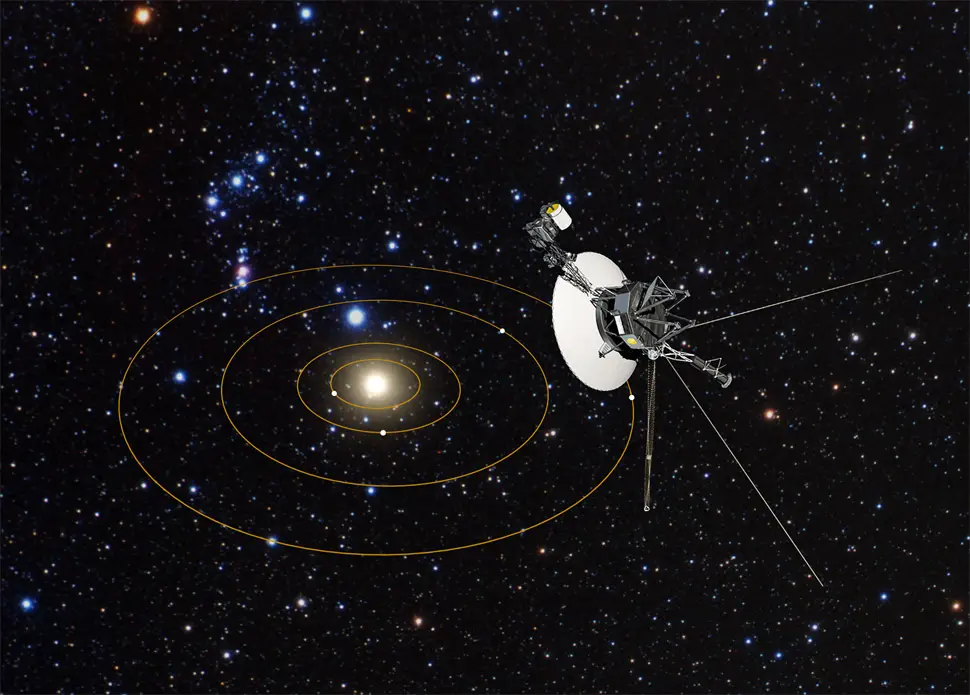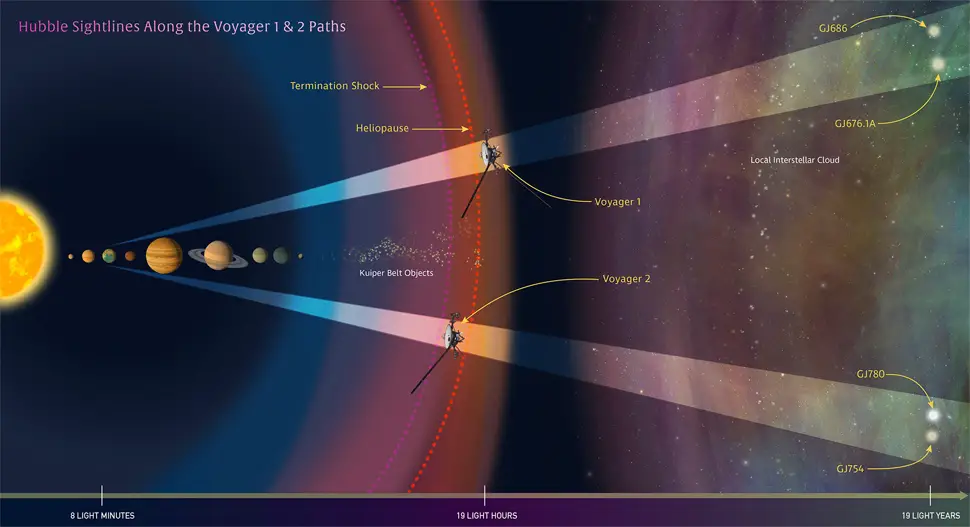
10th January 2017 Hubble provides interstellar road map for Voyager probes Astronomers using NASA's Hubble Space Telescope have measured the material along the Voyager 1 and 2 probes' trajectories as they move through space. Hubble data, combined with the Voyagers, have also provided new insights into how our Sun travels through interstellar space.
NASA's two Voyager spacecraft are hurtling through unexplored territory on their road trip beyond our Solar System. Along the way, they are measuring the interstellar medium, the mysterious environment between stars. NASA's Hubble Space Telescope is providing the road map – by measuring the material along the probes' trajectories as they move through space. Even after the Voyagers run out of electrical power and are unable to send back new data, which may happen in the mid-2020s, astronomers can use Hubble observations to characterise the environment through which these silent ambassadors will glide. A preliminary analysis from Hubble reveals a rich and complex interstellar ecology, containing multiple clouds of hydrogen laced with other elements. Hubble data – combined with the Voyagers' – have also provided new insights into how our Sun travels through interstellar space. "This is a great opportunity to compare data from in situ measurements of the space environment by the Voyager spacecraft and telescopic measurements by Hubble," said study leader Seth Redfield of Wesleyan University in Middletown, Connecticut. "The Voyagers are sampling tiny regions as they plough through space at 38,000 miles per hour. But we have no idea if these small areas are typical or rare. The Hubble observations give us a broader view, because the telescope is looking along a longer and wider path. So Hubble gives context to what each Voyager is passing through." It is hoped that Hubble will help characterise the physical properties of the local interstellar medium. "Synthesising these insights with in situ measurements from Voyager would provide an unprecedented overview of the local interstellar environment," said Hubble team member Julia Zachary, also of Wesleyan University. NASA launched the twin Voyager 1 and 2 probes in 1977. Both explored the gas giants Jupiter and Saturn, with Voyager 2 going on to visit the outer planets Uranus and Neptune. Voyager 1 is now zooming through interstellar space, the region between star systems that contains gas, dust, and material recycled from dying stars. At 13 billion miles from Earth, Voyager 1 is the farthest human-made object ever built. In about 40,000 years, it will pass within 1.6 light-years of the star Gliese 445. Its twin, Voyager 2, currently 10.5 billion miles away, will reach Sirius in approximately 298,000 AD. For the next decade or so, until they lose electrical power, the Voyagers will take measurements of interstellar material, magnetic fields and cosmic rays along their trajectories. As shown on the diagram below (click to enlarge), Hubble complements the Voyagers' observations by gazing at two sightlines along each spacecraft's path to map the interstellar structure along their star-bound routes. Each sightline stretches several light-years to nearby stars. Sampling the light from those stars, Hubble's imaging spectrograph can measure how interstellar material absorbs some of the starlight, leaving tell-tale spectral fingerprints.
Click to enlarge
Based on the Hubble data gathered so far, the astronomers predict that Voyager 2 will move out of the interstellar cloud surrounding our Solar System in a couple of thousand years. It will spend another 90,000 years in a second cloud, before passing into a third. An inventory of the clouds' composition reveals slight variations in the abundances of chemical elements contained in the structures. "These variations could mean the clouds formed in different ways, or from different areas, and then came together," Redfield said. Early analysis of the Hubble data also suggests that the Sun is passing through clumpier material in nearby space, which might affect the heliosphere – the large "bubble" containing our Solar System that is produced by our Sun's powerful solar wind. At its boundary, called the heliopause, the solar wind pushes outward against the interstellar medium. Hubble and Voyager 1 made measurements of the interstellar environment beyond this boundary, where the wind comes from stars other than our Sun. "I'm really intrigued by the interaction between stars and the interstellar environment," Redfield said. "These kinds of interactions are happening around most stars, and it is a dynamic process." The heliosphere is compressed when the Sun moves through dense material, but it expands back out when the star passes through low-density matter. This expansion and contraction is caused by the interaction between the outward pressure of the stellar wind, composed of a stream of charged particles, and the pressure of the interstellar material surrounding the star. The Hubble Space Telescope is a project of international cooperation between NASA and the European Space Agency. NASA's Goddard Space Flight Centre in Greenbelt, Maryland, manages the telescope. The Space Telescope Science Institute (STScI) in Baltimore, Maryland, conducts Hubble science operations. STScI is operated for NASA by the Association of Universities for Research in Astronomy in Washington, D.C. The Voyagers were built by the Jet Propulsion Laboratory (JPL), which continues to operate both spacecraft. ---
Comments »
|








